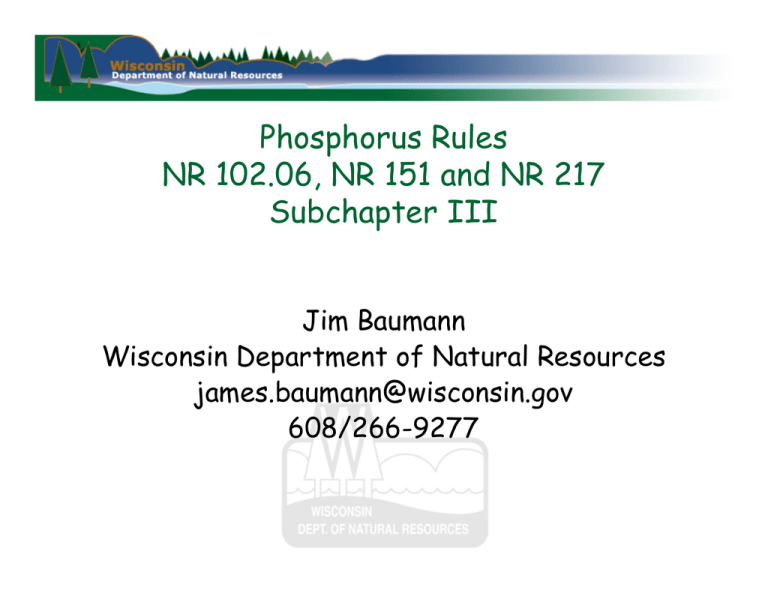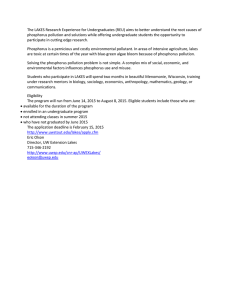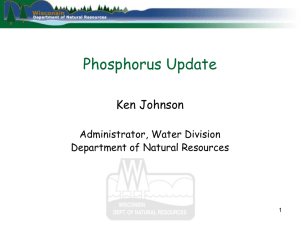Phosphorus Rules NR 102.06, NR 151 and NR 217 Subchapter III Jim Baumann
advertisement

Phosphorus Rules NR 102.06, NR 151 and NR 217 Subchapter III Jim Baumann Wisconsin Department of Natural Resources james.baumann@wisconsin.gov 608/266-9277 Phosphorus – 3 Rule Changes • S. NR 102.06 – phosphorus water quality standards criteria for streams, lakes and Great Lakes • Ch. NR 151 – additional nonpoint source performance standards and prohibitions – phosphorus index for farm fields • Subch. III, NR 217 - water quality based effluent limits Status • NR 102 and NR 217 changes became effective December 1, 2010 • EPA approved NR 102 changes on December 30, 2010 • NR 151 changes became effective January 1, 2011 • Guidance being developed on a number of topics Why Develop the Criteria • Obvious water quality problems in state • EPA requirement Algal Mats on Lake Michigan Beaches • Discourage beach use • Clog power plant water intakes • Increase disease risk to humans and wildlife • Inhibit national golf tournaments Algae covering streams • Algae detrimental to aquatic life Human Health Concerns • Toxic algae Criteria uses include • Goal for lake and stream management • Used as a factor to determine impaired waters (or not impaired) • Target for TMDLs • Basis for water quality based effluent limits for point sources Chapter NR 102 – P Criteria • • • • • • Rivers – 100 ug/l (46 listed) Streams – 75 ug/l Lakes and Reservoirs – 15 – 40 ug/l Lake Michigan – 7 ug/l Lake Superior – 5 ug/l No ephemeral streams, wetlands, LAL waters “Rivers” 100 ug/l Basis for Lake Criteria • Minimize risk of nuisance algal blooms – – 5% chance of 20 ug/l chl. a bloom – 1% chance of 30 ug/l chl. a bloom • Protect sport fisheries • Prevent shift in shallow lakes from macrophytes to algal domination • Maintain dissolved oxygen in hypolimnion of 2-story lakes • Protect and provide margin of safety for deep seepage lakes Specific Lake Criteria • 2-story lakes – 15 ug/l • Stratified drainage lakes – 30 ug/l • Stratified seepage lakes – 20 ug/l • Non-stratified lakes – 40 ug/l • Stratified reservoirs – 30 ug/l • Non-stratified reservoirs – 40 ug/l Site-specific Criterion • “Mentions” process for developing sitespecific criterion – Must have scientific rationale – Must be adopted by administrative rule – Must be approved by EPA • Most applicable to reservoirs and 2story lakes Phosphorus Criteria for Lakes • Don’t apply to lakes of less than 5 acres in size • Don’t apply to wetlands • Waters impounded that don’t have sufficient water residence time to be considered as a reservoir (e.g. millpond) Phosphorus from many Point Sources and Nonpoint Sources NR 151 et. al.— Nonpoint Source Performance Standards and Prohibitions Amendments “Quasi-enforceable” Implementing Programs • Farmland Preservation/Working Lands Initiative – DATCP – Cross compliance requirements • Environmental Quality Incentives Program (EQIP)– USDA – NRCS • County ordinance compliance • Nonpoint Source Program Phosphorus Index • Applies to croplands, pastures & winter grazing areas • PI=6, with maximum year of 12 • Based on crop rotations, soil test results, soil erosion potential, etc. NR 217, Subchapter III Phosphorus WQBELs and Implementation for Point Sources NR 217(III) – Water Quality Based Effluent Limitations • WQBEL will vary from facility to facility, based on phosphorus in receiving lake, stream or river (Subchapter II Technology based phosphorus limits of 1 mg/l or alternate in effect since 1993) 2 Ways to Derive WQBELs • Calculated through s. NR 217 mass balance equation (point source oriented calculation) • Consistent with an EPA approved Total Maximum Daily Load TMDLs Being Developed • • • • Rock River Lower Fox River/Lower Green Bay Red Cedar River Wisconsin River (down to Lake Wisconsin) • Upper Fox River/Wolf River • Milwaukee River • Others 3+ Implementation Options 1. Install, if needed, and operate needed technology 2. Pursue water quality (pollutant) trading 3. Implement Watershed Adaptive Management Option + Variance Implementation Option 1 • Install treatment processes, if needed, and operate facility to meet WQBEL – Extended compliance schedule may be requested and provided, if necessary Implementation Option 2 • Water quality (pollutant) trading Create a more than equivalent phosphorus load reduction through agreements with others • WWTP point source – MS4 agricultural NPS Implementation Option 3 • Watershed Adaptive Management Option Improve upstream water quality so that less stringent effluent limit is applicable – Applies in nonpoint source dominated watersheds Implementation Option 3 • Permittee agrees to interim effluent limits • Permit 1 – 0.6 mg/l – reevaluate • Permit 2 – 0.5 mg/l – reevaluate • Permit 3 – Calculated WQBEL if necessary • Permittee agrees to monitor stream • Permittee develops and helps implement plan with partners to control urban storm water and nonpoint sources in watershed Trade Example – Small-ish Community • Oxidation Ditch – average TP 0.3 mg/L • Base WQBEL limit 0.075 mg/l – $1.3 million capital expenditure – filtration – $136,000 per year O&M – $240,000 per year with CWF loan and O&M • about $150 to $175 per household per year – Trading option -- $14,000 per year • <$10 per household per year Trade Example -- Continued • Trade cost relatively low due to small difference between current mass discharge and mass discharge to achieve WQBEL. • Trade cost substantially greater if going from 4 mg/L to 0.075 mg/L. • TMDL WQBEL ~0.25 mg/L – Trading -- $5,000 per year Recent Issues -- National • January 2011, EPA directed Illinois EPA to include nutrient effluent limits in permits for a number of wastewater based on narrative criteria • March 1 Notice of Intent to sue Metro. Water Reclamation Dist. Of Greater Chicago over phosphorus discharges by NRDC, Sierra Club, Prairie Rivers Network More Recent -- Wisconsin • Governor’s Biennial Budget Bill – errata sheet – Change the effective date of s. NR 102.06, water quality standards criteria and effective date of subchapter III of NR 217, point source limits and implementation – Limits repeal of performance standards and prohibitions in ch. NR 151 to only 40% TSS control (by 2013). Change Effective Date of Standards and Permit Provisions • Concept used by EPA in Florida to develop procedures and all point source permittees to consider options • Will require EPA “acceptance” and approval of change in effective date from December 1, 2010 to a later date • Department would need to request approval If enacted, DNR activities next 2 years • Continue to implement performance standards and prohibitions – new bonding authority in bill • Complete guidance and train staff on use • Complete water quality trading procedures • Conduct monitoring needed to develop permit limits • Conduct outreach activities to municipalities and industries on options • Complete ongoing TMDLs Questions?





